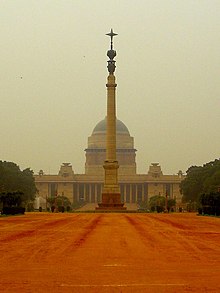Lutyens' Delhi | |
|---|---|
| Coordinates: 28°38′8.74″N 77°13′28.02″E / 28.6357611°N 77.2244500°E | |
| Country | India |
| Union Territory | Delhi |
| District | New Delhi |
| Named for | Sir Edwin Lutyens |

Lutyens' Delhi is an area in New Delhi, India, named after the British architect Edwin Lutyens (1869–1944), who was responsible for much of the architectural design and building during the period of the British Raj, when India was part of the British Empire in the 1920s and 1930s and 1940s. This also includes the Lutyens Bungalow Zone (LBZ).
Lutyens designed four bungalows in the Rashtrapati Bhavan Estate, (Viceroy House Estate); now, these bungalows lie on the Mother Teresa Crescent (then Willingdon Crescent). Lutyens, apart from designing the Viceroy's House, designed large government building and was involved with town planning.[1]
Herbert Baker, who also designed with the Secretariat Buildings (North and South Block), designed bungalows on the then King George's Avenue (south of the Secretariats) for high-ranking officials. Other members of the team of architects were Robert Tor Russell, who built Connaught Place, the Eastern and Western Courts on Janpath, Teen Murti House (formerly called Flagstaff House), Safdarjung Airport (formerly Willingdon Airfield), Irwin Amphitheatre (renamed Major Dhyan Chand National Stadium) and several government houses,[2] William Henry Nicholls, CG Blomfield, FB Blomfield, Walter Sykes George, Arthur Gordon Shoosmith and Henry Medd.[1][3]
It is on the 2002 World Monuments Watch list of 100 Most Endangered Sites made by World Monuments Fund, a heritage organization based in New York.[4]

- ^ a b "Lutyens himself designed only four bungalows". Hindustan Times. 1 September 2011. Retrieved 19 November 2015.
- ^ Aman Nath (1 October 2007). "Lutyens' Delhi". Outlook. Retrieved 16 December 2014.
- ^ "A 'garden' in the centre of New Delhi". Hindustan Times. 9 June 2011. Archived from the original on 22 October 2012.
- ^ "LUTYENS BUNGALOW ZONE". World Monuments Fund. 2002.
